Life History of a Fruit
Symbol and Tradition in Parajanov’s Caucasian Trilogy
Vol. 58 (October 2015) by Moritz Pfeifer
The trees were all dead. The soil was heavy again with cactus and desert bush. Except for the small dead pomegranate trees the place was exactly the way it had been all the years of the world. William Saroyan, My Name is Aram
In William Saroyan’s short story “The Pomegranate Trees”, the narrator’s Armenian uncle buys large amounts of infertile land in central California hoping to plant pomegranate trees on it. However, the fruits that do blossom on the desert soil don’t sell. The buyer in Chicago doesn’t even know what pomegranates are. Then again, so the narrator tells us, the uncle never intended to make money with his orchard. “It was all pure aesthetics, not agriculture.” He wanted to feel at home.
Many Armenians of the diaspora, but also those who experienced Soviet industrialization and assimilation policies in the South Caucasus, must have felt like Aram’s uncle throughout much of the twentieth century, seeing their cultural roots wither like snags in the desert. Even though the pomegranate is a metaphor in Saroyan’s tale, the historical circumstances of the last century have turned the fruit into one of the most important vestiges of Armenian tradition, perhaps only matched in symbolic aura by mount Ararat. Writers like William Saroyan, painters like Léon Tutundjian, and filmmakers like Atom Egoyan have all symbolized it in their works as a safeguard of their cultural memory. Today numerous travel books cite the pomegranate as a national symbol of Armenia.
In one scene of Parajanov’s famous The Color of Pomegranates, the fruit most controversially spills juice onto a cloth forming a stain that looks like the shape of the ancient Kingdom of Armenia. This image has led some critics to conclude that the pomegranate represents a national symbol for the director, expressing sympathy with Armenian libertarian traditions and perhaps even irredentism.1 It would, indeed, put his film at odds with its subject, the eighteenth-century troubadour Sayatʻ-Nova.2 While much of Armenia was ruled by the King of Georgia in his days, the poet did not seem to be particularly fond of questions of Armenian predominance in the Caucasus, including in his symbolic interpretation of the pomegranate. Quite the contrary. The fruit made the poet fantasize about women’s breasts, its color representing the cheeks of his beloved, not blood or national borders.
Other commentators have claimed that nationalist recourse is also at odds with Parajanov’s own ideas on the fate of the Armenia nation and the Caucasian people as a whole. Parajanov emphasized that he intended The Color of Pomegrenates to reveal the culture of the three peoples of Transcaucasia.3 Much like the poet Sayatʻ-Nova, Parajanov’s work is now mostly recognized as one defending a non-nationalistic vision.4 As a transcauscasian trilogy, the Armenian The Color of Pomegranates (1968), the Georgian Legend of the Suram Fortress (1984), and the Azeri Ashik Kerib (1988), may well be compared with the image of Sayatʻ-Nova as a “bridge-builder” between the main cultures of the Caucasus.5
The pomegranate figures so prominently in Parajanov’s work that it seems unjust to pin its meaning down to one instance of nationalist ambiguity. In all three films, the fruit appears most often in the context of important celebrations or liminal moments, accompanying the protagonists’ passage to adulthood, marriage, journey or death. As we shall see, pomegranates have symbolized religious and civic rituals throughout much of their history in the Caucasus, which is well documented by literature, art and architecture. Most importantly, the origin and practice of these traditions are not exclusive to Armenia, uniting and predating longstanding traditions of Islam and Catholicism in the region.
And yet. There is the problem of time, for most of the rituals Parajanov so lively depicts were no longer in practice when he completed The Color of Pomegranates in 1968. By the mid twentieth century, the fruit had already begun to transform into the national symbol it represents today. Even if Parajanov intended to allude to more original meanings or even prevent the fruit from growing into a national emblem, it is far from clear that his audience (including his censors) saw in the fruit what it once represented for the historical, and to a great extent imaginary, cultures populating Parajanov’s films. Indeed the idea, claimed by Western reviewers, that only Armenians would be able to understand The Color of Pomegranates turns out to be more complicating, if not false.6 Atom Egoyan recalls that the public “was walking out in doves[…]” during one screening he organized for the diasporic community in his native Canada.7 It wasn’t easier for the domestic audience. Parajanov noted that “Armenians very likely did not understand the film.”8 If understanding, here, refers to the historical origins of the symbols in the films, they certainly need explanation. It is less unlikely, however, that the public failed to comprehend the importance of symbols in representing Armenia’s national heritage in general. In fact, the Armenian and Soviet authorities allowed the film to be made in the first place precisely because they believed that a portrait on a national poet was already a symbol reinforcing Armenia’s self-perception.9 Such nation-building practices broadly aimed at recuperating traditions that had been lost during Armenia’s violent transition from an agricultural hinterland to a modern industrial center. It gave an awkward twist to a Marxian idea: make foreign rule seem less alienating by reinforcing cultural and ethnic singularity in the collective conscience. In practice, this meant that Armenians were the witnesses of a spectacle mystifying and distorting their national customs.10 In this respect, symbols like the pomegranate, more than representing real traditional customs, also provide an example of what Eric Hobsbawn called the “invention of tradition.”11
Traditionally, the pomegranate has been represented in literature, art and architecture as a symbol of fertility with remarkable continuity. On many occasions, Parajanov accurately reconstructs this meaning of the fruit. It is doubtful, however, that his intention was ethnographic precision. Symbols are rarely democratic and we will see that the fruit has always also been culturally appropriated by the dominating regimes governing the Caucasus. So, too, during Soviet Armenia. Parajanov was well aware of this. Keeping the symbol’s traditions alive would make him complicit to the nationalization policies of the regime. But there are other instances, in which he tries to subvert the fruit’s conventional meaning, pokes fun at it and explicitly associates it with violence and political control. This deconstructive use of the symbol sheds light on the director’s creative process. Parajanov has often been considered an inventor of unseen images. If most of his symbolic associations are negative reactions towards the kind of symbolic nonsense that came out of Soviet renationalization policies, his private associations can be seen as an attempt to create an alternative, uncorrupted symbolic universe.
Cheeks and Bosoms
Prior to the twentieth century, the pomegranate’s representational operations were hardly matters of national botanification. Indeed, one may be surprised by the continuity the pomegranate was able to uphold symbolizing aspects of fertility. Many ancient fertility goddesses worshiped by different pre-Christian cultures throughout the Near East like Kubaba, Inanna, Nana and Anahitā, have been associated with the fruit.12 Throughout the Ancient Orient, pomegranates were used as aphrodisiacs in fertility cults. A Neo-Assyrian rite against impotence from the ninth century BC thus recommends unfortunate men to recite three times the verse: “The beautiful woman has brought forth love. / Inanna, who loves apples and pomegranates, / Has brought forth potency” and then “give the fruit to the woman and have her suck the juices. / That woman will come to you: you can make love to her.”13 Borrowing from such practices, the classical scholar Christopher A. Faraone has suggested that “there is a special erotic character of the pomegranate” in the Greek myth of Persepone (seventh century BC), in which Hades gives the kidnapped girl a pomegranate to eat, whereafter she is obliged to remain his wife.14 The pomegranate has similar properties of seduction and desire in the Song of Solomon of the Old Testament, which some scholars suggest is rooted in some kind of pagan festive performance.15 The narrator in the poem describes his beloved: “your cheeks are like halves of a pomegranate behind your veil” (4:3) and the woman later invites him to try “the juice of my pomegranates” (8:2), which has been interpreted to denote her breasts.16 The second century Roman geographer Pausanias gives an account of the origin of Attis in Phrygia ascribing his birth to Nana, a virgin, who was impregnated by putting a pomegranate in her bosom.17 The pomegranate is thus most often represented as a gift or remedy with divine powers capable to impregnate, heal impotence, change the mind of unwilling lovers and seal marital contracts.18 It is not entirely clear what part of these mythological and religious symbolisms were based on rituals. Most likely social practices and mythological representations mutually influenced each other.19 It has often been noted that it used to be custom for brides in the Caucasus to throw a pomegranate against a wall so that the scattered seeds would then ensure their pregnancy.20 Clearly, the pomegranate’s symbolic and ritualistic properties of fertility, sexual desire, and marriage were shared by many early Mediterranean and Near Eastern cultures.
Armenian medieval and modern literature draws heavily on the two similes of breast and cheeks found in the Old Testament. They go all the way back to the 10th century, when Grigor Narekatsi, who wrote a commentary on the Song of Songs, mentioned “pomegranate-hued cheeks” in a birthday melody to an unspecified lady.21 In a poem entitled “Song of Nativity”, he also establishes a breast parallel writing: “in the midst of your bosom is a pomegranate tree”.22 In the 16th century, more explicit associations with fecundity, sexuality and desire pervade Armenian love songs and poems, for example in Hovasap Sabastatsi’s “You Are More Comely than a Pomegrenate Tree”, in an “Ode to Love and Joy” by Ghazar Sebastatsi, who writes “you’re face is as ruddy as the pomegranate.”23 Sixteenth century writers Nahabed Kouthag compared his love to an orchard of pomegranates and Nahapet Kuchak saw in the fruit a means of seduction. And finally, two centuries later, Sayat’-Nova saw women’s breasts in the fruit, for instance when the poet solicits his beloved “to cure his folly with the pomegranates of her bosom.”24
The fruit had similar connotations in medieval Persian literature and art. The breast comparison can thus be found in al-Tabari’s tenth-century History of Persia under the heading “Thus should be the Characteristics of a Persian Maiden”, where breasts are described as anār (pomegranates) and in the poems of Abu Nuwas (8th century) and Rudaki (9th century).25 Two centuries later, Nezami wrote in the “Tale of the Princess of the Seventh Clime” of his famous Haft Paykar “The apples of her chin to eat; taste pomegranates from her breasts.”26 Later poets such as the fourteenth-century Hafez kept the erotic connotation of the fruit alive. As a symbol for the delights of maidens and the pleasures of earthly life, the fruit survived well into the Qajar dynasty. The pomegranate also figured prominently in Persian miniatures depicting love scenes accompanying many Persian texts. For instance, pomegranates decorate 13th century miniatures of Nezami’s Haft Paykar in almost every love scene. Variations of such depictions are abundant in Persian art and can even be found on the sixteenth century wall paintings of Chehel Sotoun palace in Isfahan.
In The Color of Pomegranates, the aesthetic references to this tradition are intended. Parajanov has described his film as a series of Persian miniatures.27 As James Steffen has shown, the director frequently visited the collection of Persian art of The Art Museum of Georgia, and in an interview in Ekran he specifically quotes Qajar-era painting as an influence in this regard.28 Footage from the film’s outtakes includes shots of several paintings of nineteenth century paintings of the collection in Tbilisi, such as Twins, Persian Dancer and Lovers with a Servant. Similar paintings depicting pomegranates in the context of love scenes are also part of that collection. In Ashik Kerib, Parajanov used these paintings during the opening titles and the engagement and wedding ceremony in the beginning and end of the film.
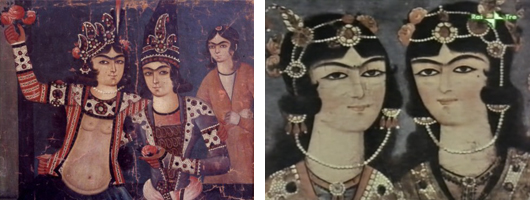
“Two Lover with a Servant” and “Twins” (in “The Color of Pomegranates” rushes), Qujar-era, unknown Iranian artists, Art Museum Georgia
In fact, the erotic connotations of the fruit are perhaps most straightforward in Ashik Kerib. The tale is based on the short story of the same name by Mikhail Lermontov and is about another troubadour (ashugh) who has to go on a journey to become rich before he is allowed to marry the woman of his dreams. Pomegranates abound in the beginning of the film. The fruit is served on tables, shown as a stone relief, in a tree of life fresco, and, finally, decorates the surroundings in a garden scene, in which the couple sits on a rug under pomegranate trees and kisses. Before they embrace, the woman gives him a pomegranate to eat, a ritual that she repeats before the poet embarks on his journey. The gesture is highly reminiscent of the fruit’s traditional symbolism as a gift setting the seal on a marriage covenant. The aphrodisiac connotation is made obvious when Ashik sucks on the fruit in the garden scene. Later in the film, when the poet achieves his goal and returns home, paintings and pomegranates reappear in the final wedding ceremony. Like in traditional Persian art and literature, the pomegranate thus provides a frame to the story, symbolizing different stages in the couple’s love.
In some ways, The Color of Pomegranates upholds also the erotic connotation of the fruit. During the chapter depicting Sayat-Nova’s childhood in Tbilisi, the young Sayat-Nova thus plays on the roof of one of the city’s Turkish-style sulfur baths. He peeks through a window and observes a male and a female bather. In the script, the bathers are King Erekle II and his sister Ana with whom the poet later falls in love. The bathing scene includes a shot of a pomegranate table and awakens the poet’s sensual desire. It is quite possible that the nude scenes were initially intended to be far longer and that they did not pass censorship.29 In one shot belonging to the bathing sequence, Erekle stands next to his throne wrapped in a red cloth holding a pomegranate in his hand.30 The king lifts the fruit and looks at it in contemplation, conveying a more melancholy sense of longing. The scene is contrasted with a more humorous shot showing a group of seven half-naked bathers playing with pomegranates. Next to the lonely king, the men’s handling of the fruit conveys a sexual if not homoerotic sense of desire. A similar scene included later in the film shows fourteen monks devouring pomegranates in front of a monastery while Sayat-Nova stands dispirited at the margins. Like before, the pleasure of the group is weighed against the poet’s melancholy.
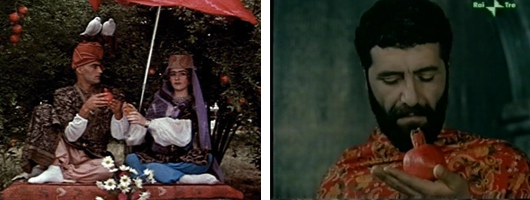
Ashik receives a pomegranate from his beloved in Ashik Kerib and King Erekle contemplating a pomegranate in the rushes “The Color of Pomegranates”
Parajanov has described his style as poetically associative.31 But the fruit’s traditional symbolic meanings seem to provide at least some narrative continuity to the film. During the poet’s youth, the fruit is associated with sexual awakening and artistic sublimation. As the poet reaches adulthood and especially during his austere spiritual retreat, however, it fails to uphold its creative and erotic connotations. Shortly after the scene with the pomegranate eating monks, Sayat-Nova appears to rediscover sensual pleasures when he dips a bowl into a wine-jar, drinking so passionately that the wine spills out from the side of his mouth over his cloak. However, the scene lacks the playful innocence of the earlier bathing scene, lust being represented here as compulsive gratification. This accurately reflects the experience of the real Sayat-Nova. After losing his privileged role as the court poet of Erekle, he became a monk, albeit a married one, and used pomegranate metaphors in a less playful manner. He now referred to the “secret way to the pomegranate of your bosom” in the context of unrequested love.32 Later in the film, the symbol disintegrates completely. An arm in medieval armor thrusts a dagger into a white wall causing the fruit to bleed. In the next shot, the same dagger lies under three crushed pomegranates, and shortly after a youth spills wine over the poet’s body symbolizing his death. Similarly to Ashik Kerib, the pomegranate thus frames the story. Only that this time it makes a conflicting turn representing melancholy, creative and sensual frustration, and ultimately death.
Parajanov uses the fruit’s erotic symbolism in this negative sense again in the script of his unfinished adaptation of Lermontov’s Demon. During the climactic moment in Lermontov’s poem, when the Demon succeeds in seducing his Georgian beloved Tamara and causes her to die, the script reads: “And the spirit touched her breasts . . . the pomegranate between her breasts . . . It seemed to Tamara that she cried out . . . A hand crushed the pomegranate.”33 In a way this scene sums up what happens to the fruit in The Color of Pomegranates. It ends up representing the exact opposite of its symbolic tradition: destruction replaces creation, repulsion replaces desire, death replaces fertility.
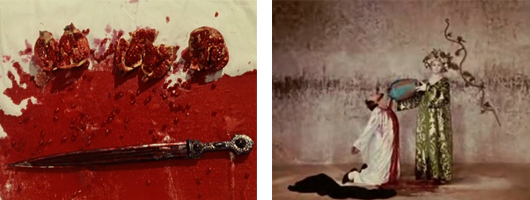
Crushed pomegranates and Sayat-Nova’s death in “The Color of Pomegranates”
What prompted Parajanov to deconstruct the fruit’s traditional symbolic meaning? One reason may be given by Sayat-Nova himself. As mentioned before, the tragic events of his dismissal prompted him to adopt a more gloomy tone of voice. The Color of Pomegranates has often been quoted as an autobiography of some sorts.34 Like Sayat-Nova, Parajanov fell into disrepute with the authorities. Even though Colors of the Pomegranates was produced prior to his arrest in 1973, he already had to deal with censorship and scrutiny during previous productions. If Parajanov didn’t directly identify with the poet’s exclusion as a minstrel from the Georgian court, he certainly related to the emotional despair and thwarted idealism of Sayat-Nova’s late poetry. “I am he whose life and soul are torment”, reads a quote in the beginning of the film. But Sayat-Nova hardly ever betrayed his own metaphors. Their darker variations always stayed within the limits of the original sense: an unfulfilled desire is still a desire. What distinguishes Sayat-Nova from Parajanov, then, is precisely the fact that while the world fell apart for both, the symbols representing the world only crumbled for the latter.
Parajanov’s relation to traditional symbols would not be half as complicated if the Soviet Union didn’t encourage artists to embrace them. As mentioned above, the official Soviet policy of korenizatsiia (“nativization”) consisted of boosting Armenian’s national awareness in an effort to make modernization seem culturally sensitive.35 The Soviet Union thus fortified traditional practices they deemed representative of the region’s history and culture. The problem was that modernization, by definition, meant that people’s living conditions dramatically changed. For example by 1939, Yerevan’s urban population tripled. With most people living and working in cities, it was considerably difficult to keep traditional practices such as harvest feasts or elaborate marriage ceremonies alive. But then again, the point of “nativization” was never to bring back the good old days but to give the illusion that they never vanished. It was a question of representation.
With regards to the fruit at the center of this enquiry, it naturally played a part in this process. Thus shortly after Yerevan became the capital of Soviet Armenia in 1920, the architect Alexander Tamanyan was given the task to redesign the city so that it could host its growing flood of residents.36 His architecture heavily drew on the decorative and iconographic elements of the medieval repertoire. The pomegranate motives on the façades of the government house or the market hall on Lenin Square (today’s Republic Square) quoted a diverse group of architectural monuments from religious monasteries to oriental temples, and resurrected an ancient iconography that had not been a significant part of architecture for at least five centuries. Yet in an article for VOKS, the architect Karo Alabyan of the Academy of Architecture proudly claimed that “in the slender columns with their magnificent capitals of rich ornament into which are naturally woven the fruits of Armenia – grapes, pomegranates, etc., Tamanyan revived the best traditions of his people’s architecture.”37
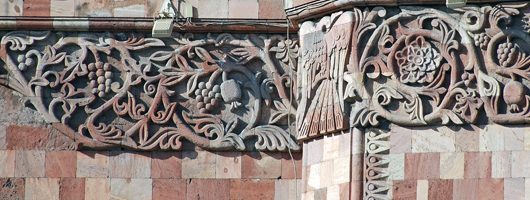
Pomegranate motifs on the Government House of Yerevan’s Republic House
The pomegranate was not carved in stone. Cinema turned out to be an ideal medium for what Yuri Slezkine called “the chronic ethnophilia of the Soviet regime.”38 The second Soviet Armenian fiction Shorn u Shorshore (1926) opens on a pomegranate tree, representing scenes of rural idyll that would inspire Armenian cinema long after WWII. Abundant banquets and traditional peasant feasts featuring pomegranates could be admired in films like Pepo (1935), Armenia’s first sound film, which was hailed for “preserving Armenia’s national identity, customs and culture”39, or in the The Girl of Ararat Valley (1949), where tradition and modernity unite in the film’s final ceremony. Finally, more mythological material came out of movies like Anahit (1947), in which the legendary heroine is offered a gift that looks like a golden pomegranate.
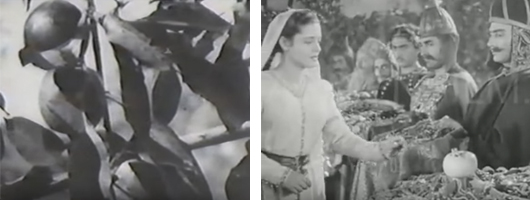
Pomegranates opening the film “Shorn u Shorshore” (1926) and a pomegranate jewel in the folktale “Anahit” (1947)
Ethnographic symbolism in movies and architecture performed a spectacle. While traditional civic and religious practices could not keep up with the changing political and social order, symbolic references to folkloric peasant culture and mythology reinforced national unity. The fact that symbols like the pomegranate were somewhat meaningless without a context didn’t matter, because their ubiquity gave the impression that their true realization had only become possible with the establishment of Soviet Armenia. It was only now that age-old vestiges finally came to disclose their true meaning of a sovereignty regained.
One should be careful, however, to conclude that new national symbols had previously enjoyed an existence free of ideological manipulation. Historically, it is quite likely that the pomegranate led a parallel life as a symbol of sovereignty that is at least as old as its fertility associations.40 Changing cultures rarely adopt symbols for the sake of artistic inspiration. The symbolic history of the pomegranate is also a history of cultural appropriation. Similar to the multicultural instances of the cheek and breast metaphors, we can thus find overlapping representations of power allegories throughout the history of the Near East. In medieval Persia, vine-scrolls and pomegranates decorating palaces and churches were intended to serve as signs of caliphal rule.41 Pomegranates famously ornate Armenian churches and monasteries. Muthmann has shown that caliph Al-Muqtadir is represented on a frieze of the Church of the Holy Cross of Akdamar offering a pomegranate to King Gagik I who thrones beside him.42 Surely the caliph’s gesture was not intended to represent a declaration of love.
The symbolic connection of the pomegranate with imperial cults also had religious variations. The fruit thus decorated medieval miniatures and manuscripts such in as the Echmiadzin Gospels. According to the eleventh-century commentator Nerses Shnorhali, the pomegranate in these illustrations symbolized the sweet content of the new law within the bitter rind of the Old Testament.43 Here again, the symbol implied religious supremacy, while it was clearly borrowing from the aesthetics and iconographic universe of the traditions it tried to overcome.

Pomegranates decorating Canon Table I of the Echmiadzin Gospels and Al-Muqtadir giving a pomegranate to King Gagik I on the Akdamar relief
Did Parajanov believe that traditional symbols and practices passed through three millennia of changing civilizations, world religions, and cultures with the help of cultural diplomacy? It seems more likely that he was well aware of the fact that the ethnographic universe he was dealing with came down to him as a gigantic power struggle. It has thus been suggested that there is a subversive side to Parajanov’s use of traditional symbols. More than being efforts to accurately imitate traditions, Parajanov played with folklore and ethnography, not infrequently in contexts of caricature or parody. Recall the scene with the pomegranate eating monks, in which the fruit comically symbolizes sexual frustration instead of desire. The images of crushed pomegranates and their association with blood and death, on the other hand, leave little room for humor. Often, the symbolic reversals go beyond parody, violently destroying the very meaning they appeared to represent. Unlike the pseudo-ethnographic films mentioned above, which relentlessly tried to demonstrate culture as both continuous and unbroken, in The Color of Pomegranates this culture falls apart.
While his unfinished Demon project already conveyed this symbolic reversal, it can also be seen in his next completed film, The Legend of Suram Fortress (1968). Interestingly, the pomegranate starts off in this film the way it left The Color of the Pomegranates: in combination with a dagger. It appears in a scene in which Osman-Agha tells the story of his captivity that precedes his mother’s violent death. In the scene, Osman-Agha is tortured by his master who chops pomegranates above his head. The fruit thus connotes political violence, adjusting to the film’s general critique of serfdom and religious oppression. In contrast, in the rushes of The Color of the Pomegranates there is another scene in which fresh pomegranates decorate a relief of Haghpat Monastery that depicts the sons of Princes Smbat and Kurik holding a church. Alone, this ceremonial image could surely be interpreted in the context of more patriotic sympathies representing the survival of the Christian faith.44 But the interpretation gets complicated, if not undermined, in the The Legend of Suram Fortress, where the pomegranates are symbolically beheaded in response to the character’s religious and political identity.
Perhaps because of their oneiric beauty, little attention has been given to the destructive force in Parajanov’s films. Indeed, it may be impossible to tear any positive conclusion out of his oeuvre, so often do the meanings he sets up turn against themselves. All is negativity. The pomegranate shows this perhaps more clearly than any other symbol in his films. If it purports to represent desire, there will be another scene in which it represents grievance. If it endorses cultural and religious heritage, it will show up somewhere else criticizing corruption and authority. In this respect, Parajanov appeared to be highly sensitive of the conflicting uses and abuses of symbols that defined his time and society. Even if a symbol like the pomegranate once had a place in endearing rituals of true romance, it cannot be protected from propagandistic manipulation, in which its very positive meaning is used to feed patriotic enthusiasm or social control. One of the struggles at the center of Parajanov’s films, then, is to point at the tension of what symbols represent in the collective conscious and how that collective is. It must have seemed frightening to Parajanov to share a symbolic repertoire with the dominating political force. That may be why his symbols are impossible to pin down to one meaning, why they fold and unfold upon each other in endless multiplications. If anything, the fruit thus represents symbolic failure. One could go back to the image of the crushed pomegranates. Certainly, they “symbolize the martyrdom of Sayat-Nova and, more broadly, the tragic history of the peoples of Transcaucasia”.45 But this ignores the particular auto-destructive aspect of the symbol and the intrinsic tragedy related to the process of symbolizing in general. Tragedy, here, should thus also be regarded as the disintegration of everything the symbol was supposed to represent, including its pretense of representing Armenia or the Armenian people.
Historically, it may seem paradoxical that the more the pomegranate was shaped into a national symbol, the less it was able to uphold a connection to real cultural practices. The tragic losses of Armenian culture and civilization went par with the development of nostalgic, at times patriotic, beliefs about its traditions. Unable to sustain these traditions, symbols such as the pomegranate had the power to soothe the unforgettable pain connected to feelings of deracination and forced acculturation at the same time that they created the illusion that there really had been something like a unifying Armenian culture in the past. Art, which is by definition symbolic, is not immune to this process and it may seem ironic that Parajanov’s pomegranates can now be found on the shelf of things representing everything Armenian. Much like transitional objects for children, these symbols try in vain to keep the relation towards their representations in the real world alive but end up as dead fantasies. Cultural cynics may see the pomegranate’s definite desiccation in the key chains decorating gift shops in Yerevan. Whether to laugh about this or cry, it seems that Parajanov was not so sure himself.




Leave a Comment